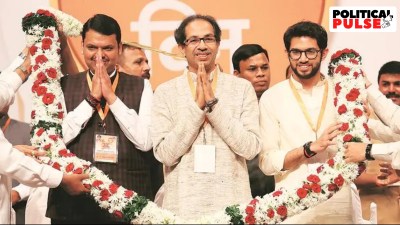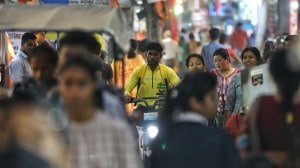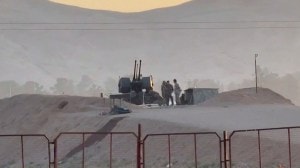- India
- International
Drought in Marathwada: Only children, old and crippled left in parched villages
Drought has forced adults, men and women, to migrate to urban areas for work.
 Sakaram Rathod with his grandchildren near Dhamoni. (Source: Express Photo)
Sakaram Rathod with his grandchildren near Dhamoni. (Source: Express Photo)
At first, the hush over Dhamoni village in Parbhani district appears to be of noon siesta, but then the padlocked doors appear. The annual seasonal migration in search of employment, common in large swathes of drought-prone Maharashtra, is more acute this year than ever before. The village economy is facing crisis following the two droughts and a hailstorm.
The 60-odd kacchha homes comprise the ‘tanda’ or extension of the 1,800-voter village, visibly more impoverished than the main Dhamoni, and where there is almost nobody left behind, but children, the aged and the disabled.
“Skipping school today,” giggles 11-year-old Sunita Nagurao Rathod, “because aajoba is unwell.” Her 76-year-old grandfather Sakaram Ganpati Rathod has a rasping cough in addition to the daily aches from a limb lost to atrophy. His sons and their wives, as well as other able relatives, are all camping as daily-wagers at a sugar factory in Parli, some 25 kilometres away from their home.
[related-post]
In his neighbourhood, 60-year-old Sonerao Rama Rathod has stayed back to tend to the livestock — a cow and a skeletal bullock. He has sent both sons to the sugar factory this year after incurring losses worth nearly Rs 4 lakh over the past 24 months.
“I sowed soyabean and cotton on my two acres and another 2.5 acres that I rented for the kharif season. But I didn’t recover a penny,” he says. He is not sowing rabi crop as his unable to get any more money on credit.

The Maharashtra government has declared nearly 24,000 villages hit by drought this year, and the refrain in administrative circles is that the water scarcity this year is nowhere near as acute as it was in the last drought in 2012-13, even though agricultural drought is severe. However, that self-assuredness is nowhere visible in the villages of Marathwada, where each one of the 8,000-odd villages has been declared drought hit and where rabi sowing this year is down by 40 per cent.
“In our villages, drought is now experienced as an inability to live here any longer,” laments Kesarbai Mulay, in her late 40s. “Life as we know it is coming to an end in the village.” Five hundred to six hundred people left the village in the last couple of months, she says. “Weddings in our families were cancelled, either because there’s no money or because girls don’t want to marry into drought-hit villages. They’ll prefer a labourer in a city to a man with a few acres of land here.” Her nephew Datta Mulay, in his late 20s, tried to make it in the city, going as far as Pune and Mumbai after his wedding was called off. “They make you work 12-14 hours in the city, and the pay is Rs 8,000 a month. I couldn’t do it,” he says, adding that those without any cushion stayed back for the paltry pay and back-breaking hours, and are unlikely to come back and face creditors any time soon .
“Forget creditors, who will ever come back and go walking two kilometres for two handis of water everyday?” asks 45-year-old Satvasheela Nagnath Mulay, fretting about the now-postponed wedding of her daughter Mohini who she says is 19 but looks closer to 16. Her husband has begun to put his small goods carrier vehicle to commercial use, taking transportation jobs nearby. Mohini used to walk 4 km to school in neighbouring Injegaon — Dhamoni’s school offers only Class VII — so she’s actually game to do another round for water, but it is rationed by whoever owns the land on which the borewell is still functional.
At Dhamoni’s two anganwadis, where 134 and 122 children below six are enrolled, attendance is 30 per cent, a seasonal low of 40-50 per cent exacerbated this year by families away looking for work. Kavita Bate, one of the two anganwadi teachers, says: “This year many more have left, and their absences are longer.” At the primary school, several children in uniform are carrying plates of khichdi home, for there’s no water in the school.
Borewells have run dry everywhere. Out of the 76 talukas, 61 are showing a dip in water tables as of October last year. Villagers also throw numbers about loosely — a few dozen animals sold off, rising substance abuse, three or four farmer suicides in the last two years, but with doors of these households locked, there’s no way to verify immediately.
An official in the office of Divisional Commissioner in Aurangabad admits that agragrian suicides, seen until recently as a pattern only in Vidarbha, have been on the rise, though there is no scientific evidence yet to join the dots unequivocally between drought, crop loss and these deaths. In any case, the administration has begun keeping count, though the numbers do not match the villagers’ unevidenced claims. There were 574 farmer suicides in Marathwada in 2014, Beed leading the tally at 153. Of these, 369 were found eligible for relief from the state. Until February 2 this year, the region has seen 56 farmer suicides, including 20 in Beed and one in Parbhani where Damoni falls, with officials expecting the numbers to rise sharply as a harsh summer approaches.
Apr 20: Latest News
- 01
- 02
- 03
- 04
- 05






































